Eight years ago, when I was a newbie just entering the crypto market, when there was only 2000U left in my account, I was thinking every day: either I turn things around in this market, or I completely fail.
Now, looking at the several million in my account, many people say I’m the chosen one, that I’m just lucky. But they only see the results; who understands the struggles behind that pile of blood and tears?
Want to know how I turned things around? It relies on the simplest yet most ruthless rolling logic. No sophisticated techniques, just rigid execution.
Let's break down this "rolling warehouse method":
1. Only recognize the overall trend, do not meddle in fragmented fluctuations. Focus attention on the major trend; if the market is unclear, stay in cash and wait, don't meddle. Too many people are always thinking about making a quick profit from short-term trades, throwing risks to the back of their minds, and end up suffering heavy losses.
2. Position control should be divided into three batches. Split each entry into three layers; it’s better to miss out than to go all-in. The consequence of betting big is that once you lose, you lose everything. So aim for steady progress, do not be greedy.
3. Stop-loss must be ruthless! You need to have a clear idea of how much loss you can bear. Set your maximum acceptable loss point in advance; when it reaches that point, cut it immediately without hesitation. Many people end up losing everything because they hesitate on their stop-loss.
4. When profitable, increase the position; when losing, decrease the position. Following the trend is the right way; if you make a profit, increase the position, and if you lose, withdraw. Counter-trend operations are like meat on the cutting board, eventually getting chopped up by the market.
With this 'rigid' logic, I rolled from 900U to 34,000, then to 180,000, and now my account has exceeded 800,000! You can be envious, but this relies on discipline and methods, not luck.
Most people lose money, and it boils down to two words: "anxiety" plus "greed". Just as they earn a little, they want to increase their positions, ending up with even worse losses. I’ve seen a brother who held on tightly when his account only had 1200U left, and eventually turned it into 60,000. This is not magic; it’s built on patience and execution.
If you want to make money, first change your bad habits! There’s enough money in the market for everyone, but you need knowledgeable people to guide you. Without this path, you can only become cannon fodder. The market is just right now; the golden opportunity is here. Don’t wait until the bull market peaks to regret: if only I had listened to you back then.
Stop waiting, start now, take advantage of this opportunity to turn things around!
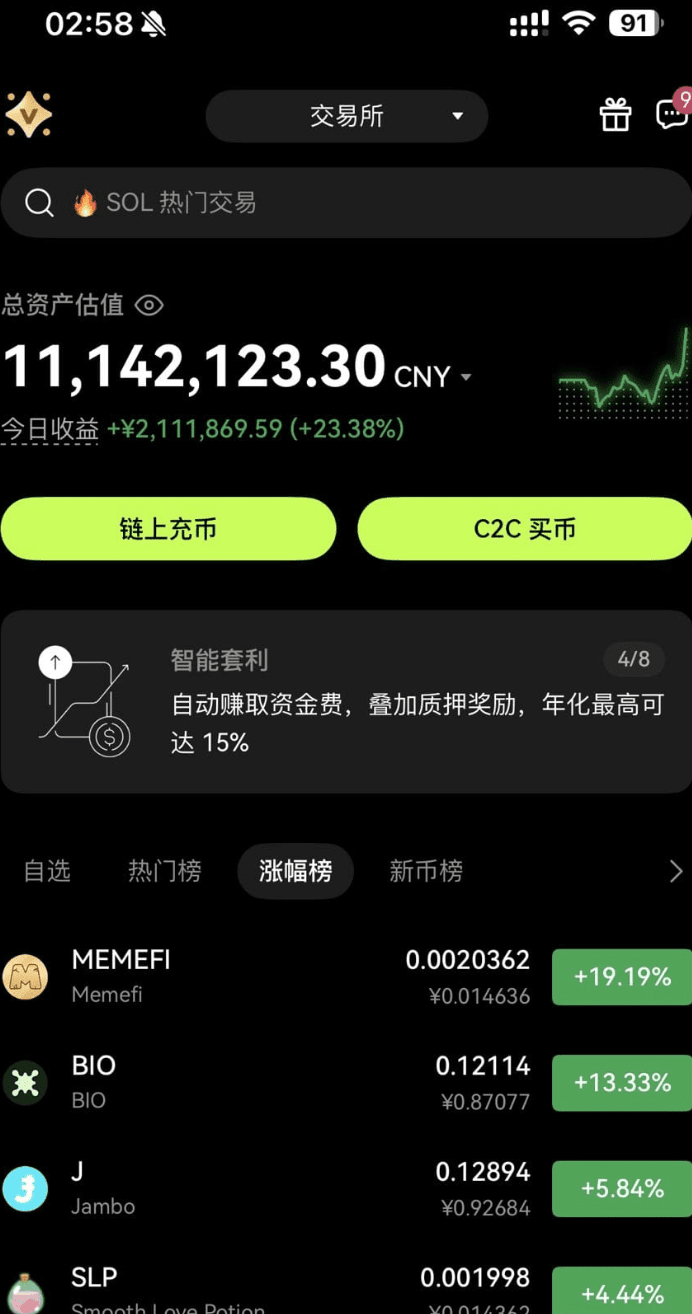
From 1000U to 70,000U, 'segmented warehousing + three-segment attack' reversed three times in the bear market; you can also copy this technical approach!
—— The core of small funds turning things around: MACD golden cross + volume-price matching, still making profits in a bear market!
1. Risk control through segmentation: three pieces of 'lifesaving meat' to survive in a bear market
The first step for small funds to turn things around is to learn to 'keep the eggs separate'! My unique "three-segment warehouse method" has helped students reverse three times in the bear market of 2023:
30% trial warehouse (300U): specifically targeting the 'MACD golden cross + increased volume' entry point! For example, last year when SOL was at 8 dollars, I entered lightly based on this signal and immediately locked in a 10% profit, never greedy!
50% trend warehouse (500U): Wait until Bitcoin breaks key levels (such as previous highs, moving averages) to enter heavily! Last year when BTC broke 28,000 dollars, I entered fully with 500U and made 25% profit in 3 days!
20% revival warehouse (200U): Even if the first two warehouses lose everything, this 200U can make you 'fully revived'! Last year during the most severe bear market, I used this 200U to catch ETH's pullback and broke even in a week!
2. Three-segment attack: capture initiation, step on pullbacks, follow continuation
In a bear market, making profits relies on rhythm; in a bull market, becoming rich relies on patience! My "three-segment attack method":
First wave: capturing the initiation (light position trial)
When the market just starts to trend, use a trial position to enter and lock in a 10% profit immediately! Last year when PEPE started, I earned 30% from a 300U light position and cashed out immediately!
Second wave: stepping on pullbacks (profit addition)
If the pullback does not break the previous low, then add to the position and expand the gains by 30% of the profit! Last year when MATIC pulled back to 0.8 dollars, I used the 150U earned from the trial warehouse to increase my position and ultimately made 80% profit!
Third wave: follow continuation (heavy attack)
After the trend is clear, use trend positions heavily, but never exceed 30% of your capital! Last year in BTC's main rising wave, I entered fully with 500U and made 40% profit in 3 days!
Remember: Fluctuating markets are meat grinders; it’s better to stay in cash than to gamble randomly! Last year when BTC was hovering at 25,000 dollars, I directly stayed in cash and avoided three false breakouts!
3. Profit rolling: let money generate more money
The core of turning around with small funds is to let profits roll! My "three principles of rolling warehouse":
Floating profit of 10%: use 50% of the profit to add to the position, and cash out the remaining 50%;
Floating profit of 30%: withdraw an additional 20% as a safety cushion;
Core rule: Profit generates profit, never gamble with your capital!
Last year, using this method, I turned 1000U into 70,000U without ever using leverage!
Fourth, take profits early: when others are crazy, I withdraw first.
Rolling the warehouse is not gambling with life, but using compound interest to increase funds! Last year at the peak of the bull market, while others were chasing highs and getting liquidated, I cleared my positions based on the 'volume-price stagnation' signal; when others were cutting losses and crying, I caught the pullback meat and made enough profit!
The secret to surviving in the crypto market with small funds is not to gamble on price movements, but to execute 'segmented warehousing + three-segment attacks' to the extreme! The market is never short of opportunities; what lacks are people who can engrain simple rules into their bones.
In the crypto market, making 1 million requires either relying on a big bull market and holding on, or betting on a coin that skyrockets, or using high leverage to bet in the right direction. But most people lose money, so don’t just look at the stories of getting rich; first, think clearly about how much risk you can bear.
If you are also a tech enthusiast in the crypto market, click on the coin homepage.
Click on my avatar to follow me for first-hand information and in-depth analysis!

Ultimate guide to the 200-day moving average: professional traders teach you how to avoid being shaken out and capture the entire major trend!
The most common mistake traders make is that they always expect to find a 'holy grail of trading', ignoring the learning and experience accumulation in actual trading. It is recommended for novice traders to establish a detailed plan. This plan should set parameters for each trade, such as which market conditions are tradeable, how to enter and exit, and how to manage trades. If trading is always losing, then it is essential to reflect on one’s trading plan and make continuous improvements. The 200-day moving average is one of the most closely watched indicators.
As soon as you open financial news, you will always hear similar rhetoric:
"S&P Index breaks below the 200-day moving average - the bear market is here!"
"You should buy when the price breaks above the 200-day moving average."
"Apple's stock price closed below the 200-day moving average - it's time to sell."
But the question is: what practical help does this provide to traders?
It’s of no help.
On the contrary, it will only play with your emotions, tempting you to buy and sell at the wrong times.
But don't worry, we will completely change this situation.
What is the 200-day moving average? How does it work?
The moving average (MA) is a trading indicator formed by averaging price data, displayed as a curve on the chart.
Its operating principle is as follows...
Assuming the closing prices of Apple Inc.'s stock for the last 5 trading days are $100, $90, $95, $105, and $100.
The calculation method for the 5-period moving average is: [100 + 90 + 95 + 105 + 100] / 5 = 98
When you continuously mark these 5-period moving averages on the chart, it will form a smooth curve.
The principle of the 200-day moving average is exactly the same; the only difference is that it calculates the price data of the last 200 trading days, thus forming a longer-term moving average.
(Taking TradingView as an example) The method for setting the 200-day moving average is as follows:
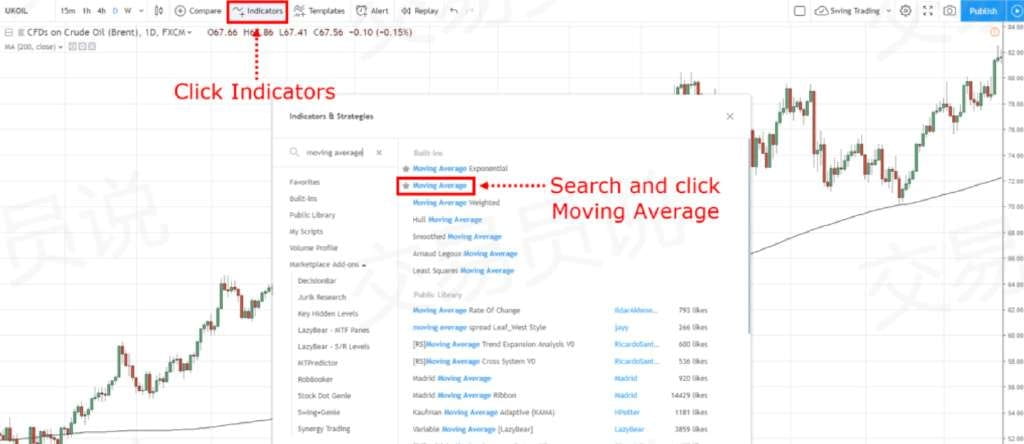
Here is an example of the 200-day moving average chart:
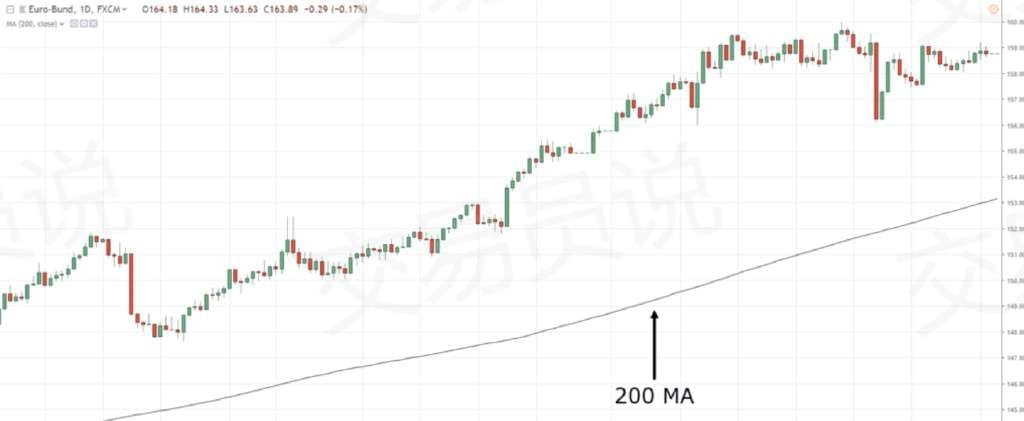
It should be noted that there are various types of moving averages, such as Exponential Moving Average (EMA), Simple Moving Average (SMA), Weighted Moving Average (WMA), etc.
But you don’t need to get tangled up in these types, because their core principles are the same (only the calculation methods differ slightly).
Next, let's get to the point...
How to use the 200-day moving average to improve trading win rates?
The key point is:
The 200-day moving average is a long-term trend indicator.
This means you can identify and follow long-term trends through it.
The specific method is as follows:
◎ When the price is above the 200-day moving average, prioritize looking for buying opportunities;
◎ When the price is below the 200-day moving average, consider selling opportunities.
The actual example is shown in the figure below:
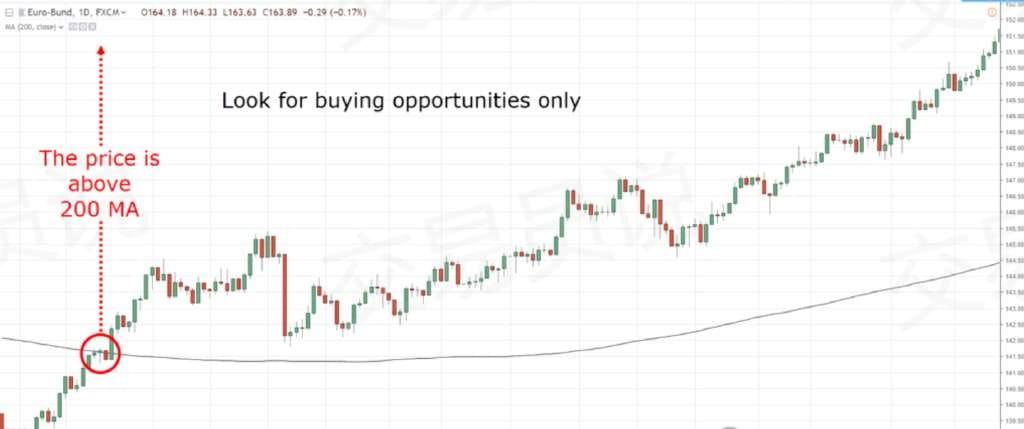
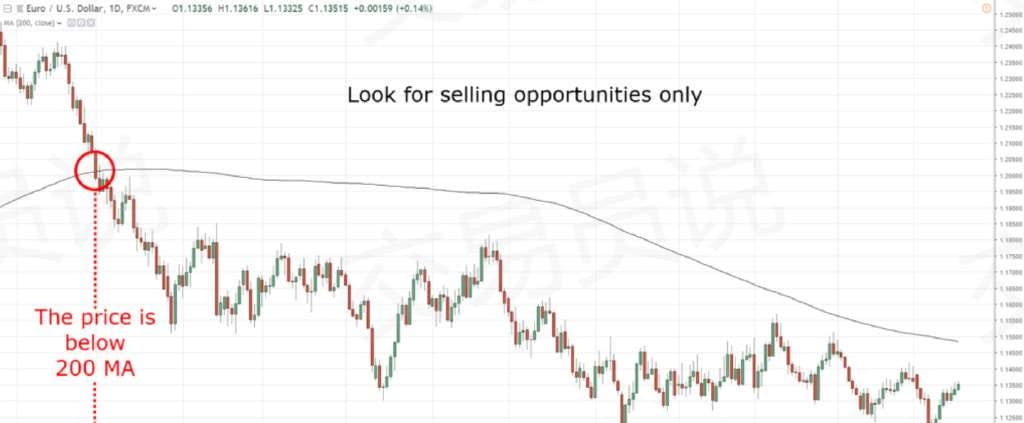
Professional advice: If you are trading stocks or spot in the crypto market, you can refer to the market index or BTC for trend direction.
For example: When the S&P 500 index is above the 200-day moving average, prioritize looking for buying opportunities in US stocks.
This simple trading strategy using the 200-day moving average can both improve the win rate and reduce capital drawdowns.
How to accurately grasp the buying and selling opportunities using the 200-day moving average?
You may ask:
"Using the 200-day moving average to judge trends is not difficult, but when is the best entry point?"
Here are several practical tips:
◎ Support and resistance levels
◎ 200-day moving average rebound
◎ Ascending triangle
◎ Bull market flag pattern
The specific analysis is as follows...
1. Support and resistance levels
◎ Support levels: Key areas in the chart that may trigger buying pressure
◎ Resistance levels: Key areas in the chart that may trigger selling pressure
Operational logic:
When the price is above the 200-day moving average, look for buying opportunities at support levels;
When the price is below the 200-day moving average, look for selling opportunities at resistance levels.
As shown in the figure below:
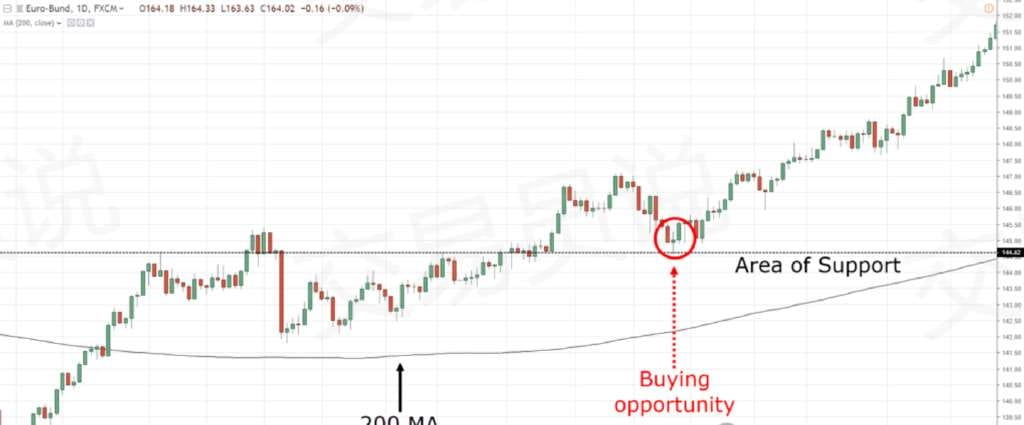
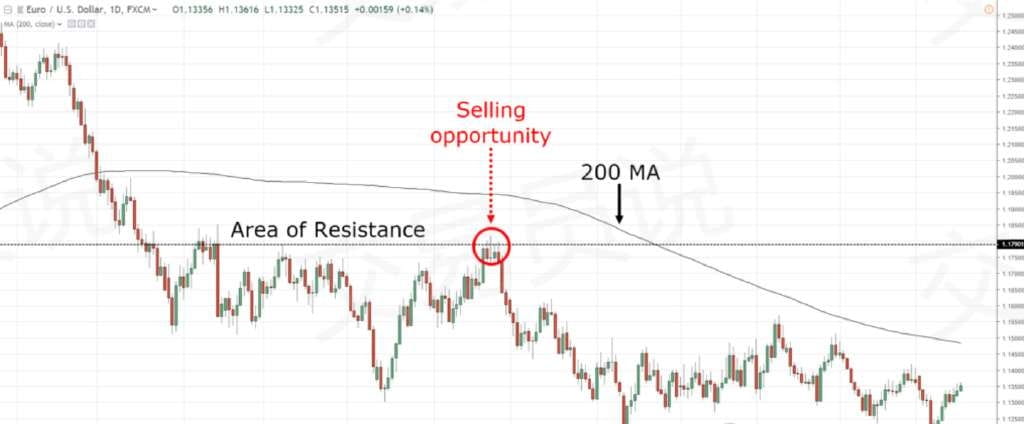
2. 200-day moving average rebound strategy
In weak trends, the 200-day moving average often forms a value area.
When the price approaches the 200-day moving average and shows a "rebound", it often indicates an excellent entry opportunity. As shown in the figure below:
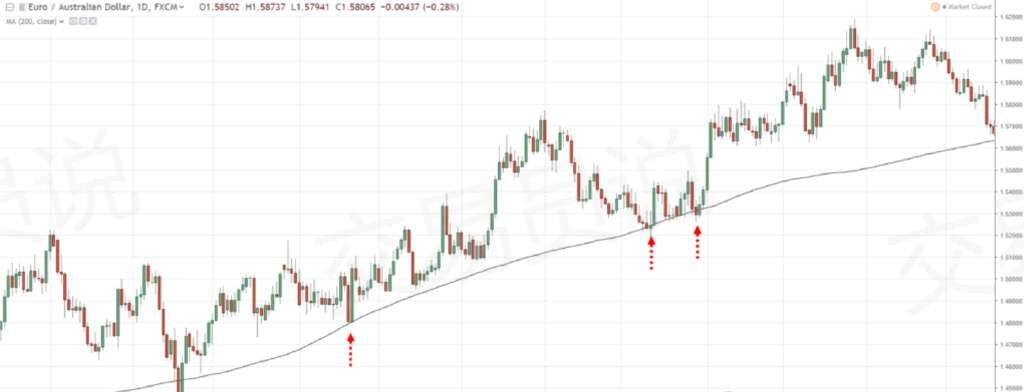
Professional advice: When the 200-day moving average coincides with nearby support/resistance levels, the trading win rate will significantly improve.
3. Ascending triangles and descending triangles
The ascending triangle is a bullish formation characterized by buyers willing to take on higher prices despite encountering resistance, indicating market strength.
Operation guide:
When the price is above the 200-day moving average (uptrend), look for an ascending triangle breakout to go long;
When the price is below the 200-day moving average (downtrend), focus on shorting the breakdown of a descending triangle.
The actual example is shown in the figure below:

Professional tip: The longer the ascending triangle forms above the 200-day moving average, the stronger the subsequent breakout tends to be.
4. Bullish flag pattern
A bullish flag pattern is another bullish chart formation.
This is a sign of price strength, as the bulls are in control and the bears find it difficult to push prices lower (hence why you see small candlesticks during pullbacks).
Therefore, in an uptrend, you can look for bullish flag patterns and buy on high point breakouts.
In a downtrend, look for bearish flag patterns and short on low point breakouts.
As shown in the figure below:
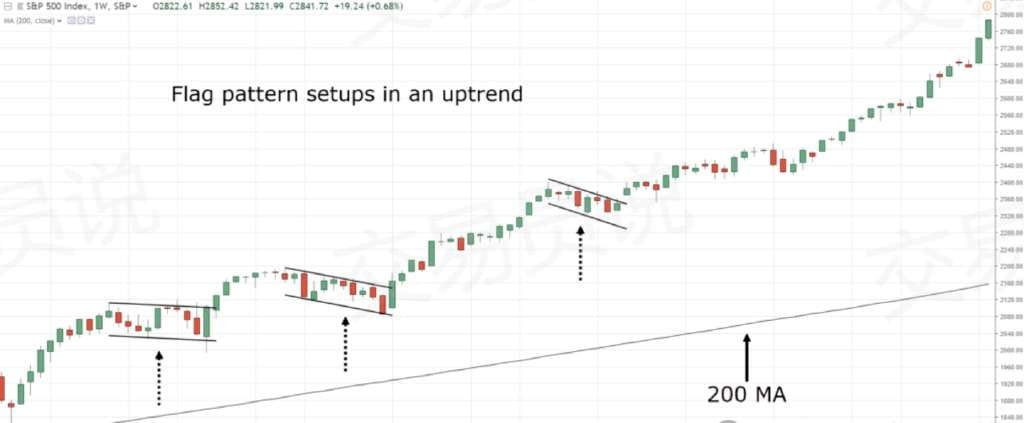
Professional tip: The best flag trading opportunities usually occur during the first pullback after the price breaks above the consolidation range.
How to use the 200-day moving average to capture major trends and avoid being shaken out during pullbacks?
If you want to ride the huge trends of the market (the trends that make other traders envious), you must give your trading space a chance to 'breathe'.
We should not cancel tight trailing stops. Instead, you must give it a buffer zone.
One method is to use the 200-day moving average for trailing stops. This means that if you go long, you will only exit the trade when the price closes below the 200-day moving average.
Or, if you short, only exit the trade when the price closes above the 200-day moving average.
As shown in the figure below:
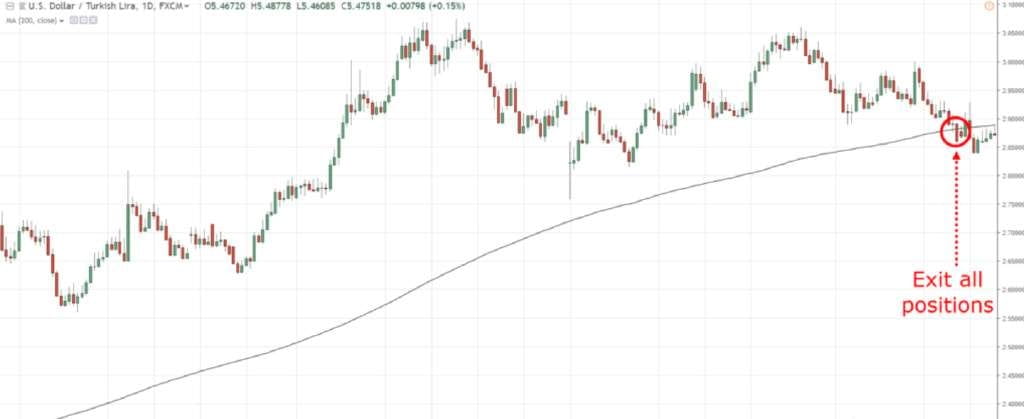
Professional tip: If you want to ride short-term trends, you can follow the 20-day moving average; if you want to ride mid-term trends, you can follow the 50-day moving average.
How to accurately identify market cycles and avoid counter-trend operations?
The market is always in dynamic change, cycling repeatedly between consolidation → trend → consolidation.
You can break down the market into four stages:
1. Accumulation phase
2. Advancing phase (Advancing)
3. Distribution phase
4. Declining phase (Declining)
(This is important, so please learn it)
1. Accumulation phase
The accumulation phase usually occurs after a downtrend.
At this time, the market presents a range-bound fluctuation pattern, with clear support and resistance levels.
You will observe that the 200-day moving average gradually flattens, with the price repeatedly fluctuating around it (commonly known as the 'whip-saw' phenomenon).
This indicates that the forces of buyers and sellers have reached a balance, and the market is in a phase of directional choice.
As shown in the figure below:
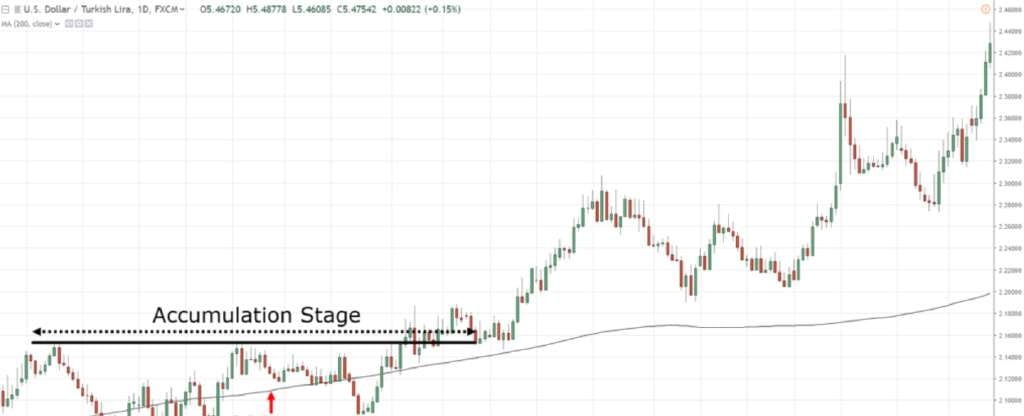
This means...
In this phase, the 200-day moving average strategy may fail. The market may break upwards or downwards: if it breaks downwards, the downtrend continues (look for shorting opportunities); if it breaks upwards, it marks the start of an uptrend, entering the next phase...
2. Advancing phase
When the price breaks above the upper edge of the accumulation zone, the market enters the advancing phase. This is characterized by a rising trend with higher highs and higher lows, with the price firmly above the 200-day moving average, and the 200-day moving average begins to turn upwards.
Look at the following example:
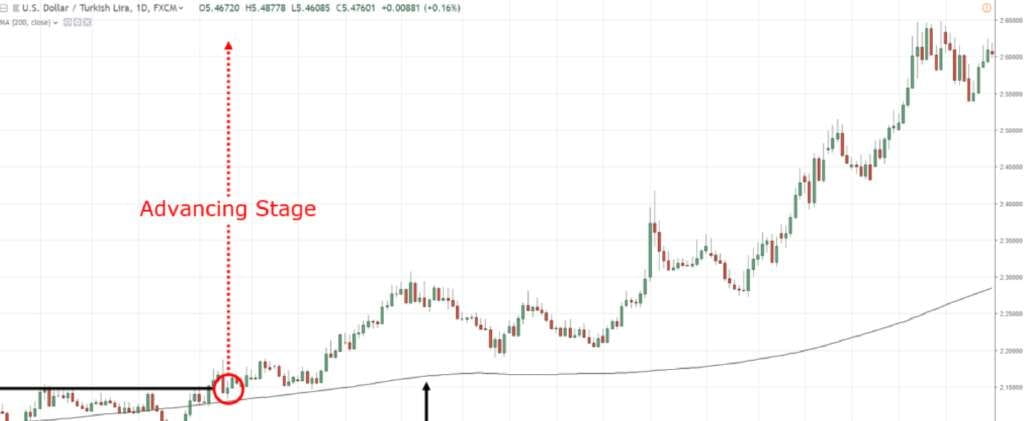
In the advancing phase, the path of least resistance is upward, so you want to be a buyer (not a seller).
There are several ways to trade uptrends:
◎ Seize the buying opportunity during the first pullback after the accumulation phase breakout
◎ Waiting for price pullbacks to convert resistance levels into support levels
◎ Focus on buy points when prices pull back to near the moving average
3. Distribution phase
The market will not always rise; when selling pressure begins to suppress prices, it will first enter the distribution phase. This is characterized by range-bound fluctuations in the uptrend, the 200-day moving average once again flattens, and the price fluctuates around the moving average, indicating that the market has entered a state of balance between bulls and bears again.
This is an example:

At this time, the market may break upward or downward: if it breaks upward, the trend continues; if it breaks downward, it indicates the beginning of a downtrend...
4. Declining phase
This is the final stage of the market cycle. When the price breaks below the lower edge of the distribution range, it enters the declining phase, characterized by a downward trend of lower lows and lower highs. At this time, the price runs below the 200-day moving average, and the moving average begins to tilt downwards.
Look at the following example:
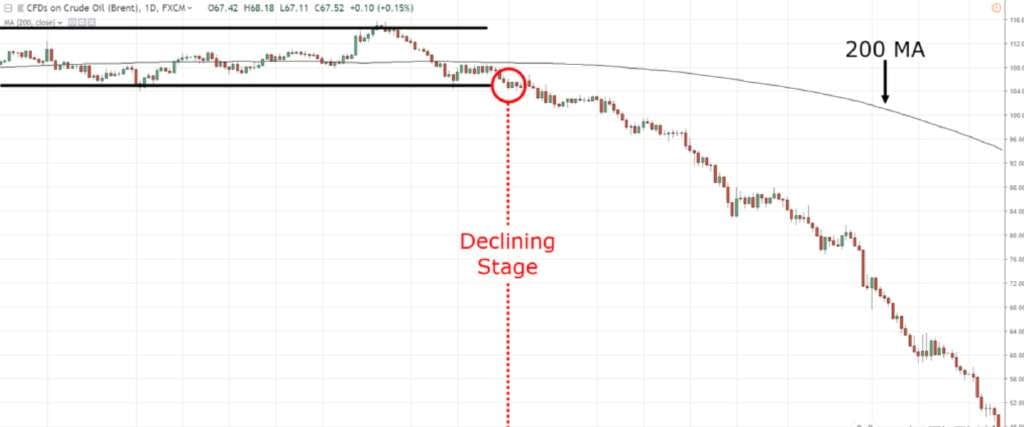
In the declining phase, the path of least resistance is downward, so you want to be a seller (not a buyer).
Similarly:
The downtrend will not last forever; when the price is low enough, it will attract buying interest, bringing the market back to the first phase - the accumulation phase, completing the cyclical cycle.
The four stages of the market are more like art than science.
Sometimes it's unclear which phase the market is in.
When this happens, your best choice is to move to another more meaningful market.
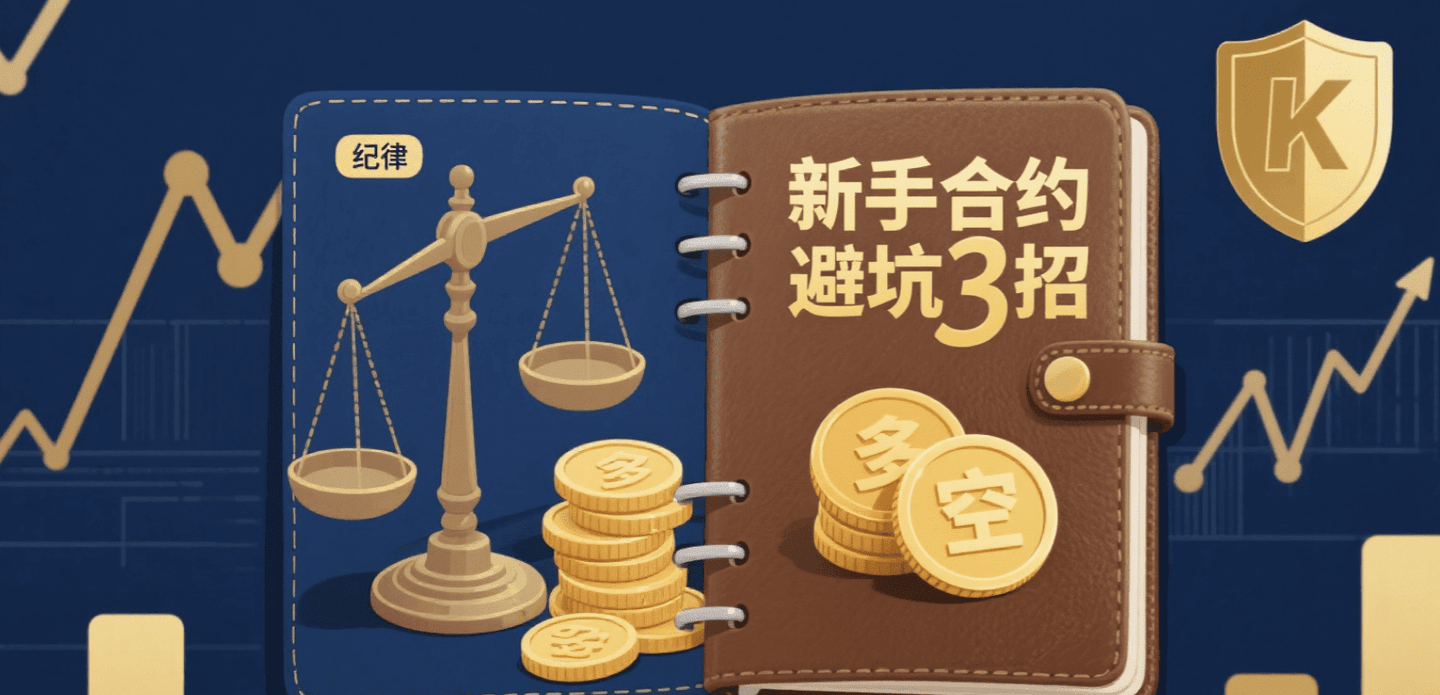
Three tactics for novice contracts to avoid traps: refuse to think like a gambler, and steadily earn profits through discipline.
First tactic: Treat contracts like flipping a coin - understand the rules before placing bets
1. Underlying logic
Going long = betting on the positive (rise), going short = betting on the opposite (fall); only correct direction can lead to profit.
Leverage is not magic; it’s an amplifier: 10x leverage = exchanging a 1 dollar coin for 10 dollars in chips; if you guess right, you earn 10 times, if you guess wrong, you lose 10 times.
2. Key points for practical operation
Before placing an order, always ask yourself three questions (limited to 3 seconds): ① Is the current trend upwards or downwards? ② Is there any significant news that may interfere? ③ Where is the stop-loss point set?
Use a 5-minute chart to find 'second confirmation' signals, such as a pullback to support after a breakout, before deciding whether to enter.
Second tactic: Replace impulsive decisions with strategy - let the system make money automatically
1. Grid trading
Applicable scenarios: Fluctuating market (e.g., BTC fluctuating in the 60k–65k range for 3 days).
Operational setup: set a grid for every 500U, automatically buy low and sell high, operating 24 hours a day.
Profit reference: Fluctuating range of 5% + 3x leverage, single grid net profit margin of 15%, average daily return of about 3%-5%.
2. Funding fee arbitrage
Core principle: When the funding fee for contracts is higher than the interest for spot holdings, go long on spot + short perpetual contracts to lock in a risk-free spread.
Case reference: A certain coin's funding fee is annualized at 18%, spot annualized at 2%, the interest spread is 16%, with a principal of 100,000U earning a guaranteed profit of 16,000U in a year.
3. Hedging trades
Applicable scenarios: The night before major events (e.g., policy announcements, data releases), with uncertain volatility direction.
Operation method: simultaneously open equivalent long and short positions, close losing positions after volatility, and retain profitable positions to achieve 'profit in both rising and falling markets'.
Third tactic: Treat risk management as a lifeline - first learn not to lose, then talk about making money
1. Position management
Pyramid addition: initial position 1%, increase 0.5% after 2% profit, total position never exceeds 3%.
Reverse pyramid reduction: reduce 1% position at 1% loss, reduce 2% position at 2% loss, strictly prevent liquidation.
2. Stop-loss discipline
Fixed stop-loss: set a 2%-3% stop-loss line upon opening a position, with automatic liquidation when the price triggers it.
Trailing stop: after reaching 5% profit, raise the stop-loss to the cost price to firmly lock in profits.
3. Emotional management
If you incur three consecutive losses, stop trading for 24 hours to avoid 'revenge trading'.
Establish a 'trading journal': record the reason for each position, profit and loss results, and your mood at the time, using data to correct impulsive actions.
4. Capital planning
Strictly separate living expenses: reserve at least 12 months of daily expenses to ensure that even if a liquidation occurs, it does not affect basic living.
Indicator assistance: MACD and KDJ are only for reference; the core judgment basis is trend + volume-price + real-time news.
Conclusion
Contracts are not a casino, but a long battle of cognition and discipline.
It is recommended to first use 1% of your funds to complete 100 practice trades on a simulated account before entering the real market;
First, train the instinct of 'not losing money', then let 'making money' happen naturally.
In the crypto market, making 1 million requires either relying on a big bull market and holding on, or betting on a coin that skyrockets, or using high leverage to bet in the right direction. But most people lose money, so don’t just look at the stories of getting rich; first, think clearly about how much risk you can bear.
If you are also a tech enthusiast in the crypto market, click on the coin homepage.
Click on my avatar to follow me for first-hand information and in-depth analysis!